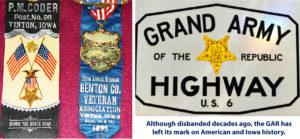Long before the American Legion, VFW or AMVETS gathered together to support fellow soldiers, remind Americans of the cost of war and teach their neighbors to appreciate the cost of the freedom they enjoy, another veterans group did the same thing decades earlier.
The Grand Army of the Republic -- made up of Union Civil War veterans -- began within a year of the end of that war. By 1890, the group had thousands of chapters and nearly 400,000 members.
In Iowa, there were nearly 400 GAR posts by the end of the 19th Century.
A history of the GAR, written in 1910 by then-commander John E. Gilman, offers this assessment of the GAR: "Its posts exist throughout the length and breadth of the country, and even outside, and nearly every State has a department organization. Its influence is felt in every city, town, and village, and it has earned the good-will and support of the entire American people. Among its leaders have been some of the most prominent men of the country."
There were several area chapters, including the P.M. Coder Post 98, of Vinton. Walker and Urbana posts are also mentioned in the archives of the Vinton newspapers; 4-H clubs and other groups used to meet in the Jefferson Township Hall in Brandon, a structure built by the GAR around 1890.
There are several well-known GAR structures in Iowa, including a sundial at the State Capitol complex. In 1947, Iowa's last two known surviving Civil War veterans, James Martin and Ebenezer McMurray, joined Governor Robert Blue as he signed a proclamation designating Highway 6 in Iowa as the Grand Army of the Republic Highway.
The Vinton post organized in 1882, and the members decided to name it after a Civil War hero who had recently passed away: Philip M. Coder. He had been serving his second term as county treasurer at the time of his death. He had not yet reached his 40th birthday.
Eventually, the GAR included all of the former Confederate states, as well. A commander wrote a letter to all members, published in local newspapers throughout the U.S., to help confederate veterans, who did not receive assistance from the federal government as most Union veterans did. See that letter here: GAR southern vetsEagle, Page8, 1902-09-05
About Philip M. Coder
A historical sketch of the Iowa 28th offers the following summary: Coder, Philip M. Age 21. Residence Benton County, nativity Pennsylvania. Enlisted Aug. 1, 1862. Mustered Sept. 2, 1862. Wounded; leg amputated May 16, 1863, Champion's Hill, Miss. Mustered out July 31, 1865, Savannah, Ga. Many soldiers and even some generals on both sides, remained in active duty during the Civil War, after undergoing amputations.
He returned to Iowa and became an elected official, serving as county recorder and treasurer, but did not live to see his 40th birthday.
Philip Coder died Sunday, Jan. 2, 1881, aged 39 years, 7 months and 9 days. The Vinton Eagle (Jan. 5, 1881) offered the following tribute and obituary: "He was the first to respond to the call of the country, going out as a Private in Co. G, 28th Iowa Infantry. He lost a leg in the service, which was a source of much physical suffering, and without doubt, it was one of the causes which hastened his death. The funeral took place from the M.E. Church, on Monday, being attended by the United Workmen and the Odd Fellows, of which organizations he was a member. Mr. Coder, as a county official, was faithful to his trust, having served two terms as recorder and was serving his second term as Treasurer at the time of his death. The mourning family have the earnest sympathy of this community."
Philip Coder is a "second cousin four times removed" to Ross Coder, one of the members of the George G. Luckey American legion Post 57, says Ross's wife, Crystal Coder. Both, she says, are descendants of Conrad Koder IV from Germany (1747-1817).
About the Battle of Champion's Hill
Approximately 250 soldiers from Iowan -- well over half of all Union KIA in this battle -- died in the Champion's Hill battle. which was part of General William T. Sherman's famous Vicksburg, Mississippi campaign.
Named after Sid and Matilda Champion, who lived near the battle site, Champion's Hill was a major victory for the Union as Sherman moved on Vicksburg.
The former Champion Hill house was turned into a hospital where according to the National Park Service, "amputations were performed with gruesome efficiency."
Philip Coder was one of many who survived that procedure there; and one of the 30,00o-40,000 Civil War amputees.
Among those trying to keep alive the memory of Union soldiers is the organization, Iowa Sons of Union Veterans of the Civil War. See their web site HERE.
See a summary of the Champion Hill battle HERE.
Descendants of Sid and Matilda Champion, whose house served as the hospital where Coder and countless other Union soldiers underwent amputations, still offer tours of the site, and other information. See their web site HERE.
See a report from a commander of the Iowa 28th, Coder's unit, at the Champion's Hill battle, HERE.
For a story about the quantity of Civil War amputations, and the process, click HERE
For a scholarly report on amputee clothing and related issues, click HERE.

Comments
Submit a CommentPlease refresh the page to leave Comment.
Still seeing this message? Press Ctrl + F5 to do a "Hard Refresh".